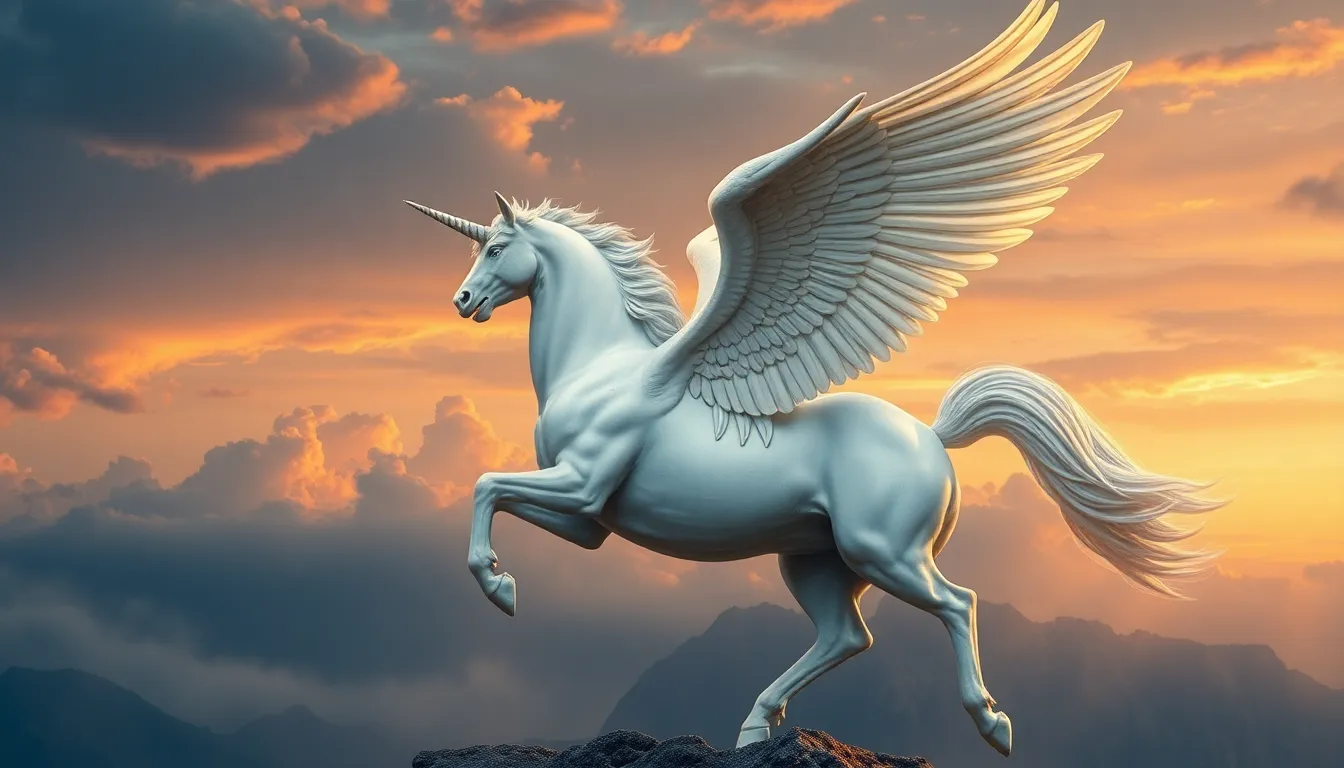The Journey of Pegasus: From Myth to Modern Interpretations
I. Introduction
Pegasus, the winged horse of Greek mythology, has captivated imaginations for centuries. Born from the blood of the Gorgon Medusa, Pegasus represents both beauty and power, embodying the spirit of inspiration and the quest for knowledge. His presence in ancient cultures underscores the significance of mythological creatures in human storytelling and artistic expression.
This article aims to explore the evolution of Pegasus from his mythological origins to contemporary representations, examining how this iconic figure has influenced various cultures and artistic forms throughout history.
II. Origins of Pegasus in Greek Mythology
The story of Pegasus begins with his extraordinary birth, a tale woven into the fabric of Greek mythology. According to legend, Pegasus sprang from the blood of Medusa when she was slain by the hero Perseus. This miraculous birth signifies the duality of creation and destruction, as Pegasus emerges from a source of fearsome power.
Pegasus is notably linked to the hero Bellerophon, who tamed the winged horse and rode him into battle against the Chimera, a monstrous creature that breathed fire. Their partnership is emblematic of the struggle between good and evil, illustrating the hero’s journey towards overcoming seemingly insurmountable challenges.
In ancient Greek culture, Pegasus symbolizes various aspects, including:
- Inspiration for poets and artists
- The pursuit of wisdom and knowledge
- The potential for transcendence and elevation
III. Pegasus in Ancient Art and Literature
Pegasus has been a prominent figure in classical art, appearing in sculptures, pottery, and mosaics. Artists of the ancient world often depicted him in flight, emphasizing his ethereal nature and connection to the divine.
Literary references to Pegasus can be found in the works of ancient poets such as Hesiod and Homer. Hesiod describes Pegasus as the horse of the Muses, reinforcing his association with creativity and artistic inspiration. Homer, in his epics, alludes to Pegasus as a symbol of heroism and valor, further embedding the creature in the cultural consciousness of ancient Greece.
The cultural significance of Pegasus during this time can be summarized as follows:
- A representation of divine inspiration
- A motif for heroic deeds and adventures
- A symbol of the connection between the earthly and the celestial
IV. The Evolution of Pegasus in Medieval and Renaissance Art
During the medieval period, interest in classical mythology experienced a revival. Pegasus reappeared in literature and art, often reimagined through the lens of chivalry and courtly love. Medieval manuscripts featured images of Pegasus, linking him to the ideals of knightly virtue and the quest for glory.
The Renaissance marked a significant transformation in the portrayal of Pegasus. Artists such as Leonardo da Vinci and Sandro Botticelli incorporated Pegasus into their works, showcasing him in dynamic poses that highlighted his grace and power. The symbolism of Pegasus shifted during this period, aligning more closely with themes of humanism and the celebration of individual achievement.
Key aspects of Pegasus in Renaissance art include:
- Emphasis on beauty and anatomical accuracy
- Connection to the ideals of Renaissance humanism
- Representation of the harmonious relationship between humanity and nature
V. Pegasus in Modern Literature and Popular Culture
In contemporary literature, Pegasus continues to inspire writers across genres. From fantasy novels to poetry, the winged horse embodies the spirit of adventure and the quest for knowledge. Notable examples include:
- The “Percy Jackson & The Olympians” series by Rick Riordan, where Pegasus is a significant character
- Poems by modern authors that utilize Pegasus as a metaphor for creative inspiration
Pegasus has also made a substantial impact on film and television, appearing in adaptations of Greek mythology and fantasy narratives. His portrayal often emphasizes his majestic and heroic qualities, resonating with audiences around the world.
The influence of Pegasus on modern fantasy and pop culture can be seen in:
- Merchandising and branding featuring Pegasus symbols
- Video games that include Pegasus as a character or mount
- Artistic representations in cosplay and fan art
VI. Pegasus as a Symbol in Contemporary Society
Today, Pegasus serves as a powerful symbol in various contexts, including branding and advertising. Many companies utilize the image of Pegasus to convey themes of speed, creativity, and aspiration.
Pegasus is also viewed as a symbol of inspiration and creativity, often referenced in discussions about artistic endeavors and the pursuit of dreams. His legacy as a figure of empowerment remains relevant, encouraging individuals to reach for their goals and embrace their potential.
The relevance of Pegasus in today’s cultural narratives includes:
- Representation in motivational literature and speeches
- Incorporation into educational contexts as a symbol of learning and growth
- Use in social media campaigns that promote creativity and innovation
VII. Artistic Interpretations of Pegasus in the 21st Century
The 21st century has seen a resurgence of interest in Pegasus through modern artistic renditions. Visual artists, digital creators, and illustrators have reinterpreted Pegasus in unique and innovative ways, often blending traditional motifs with contemporary styles.
Pegasus has also found a place in social media and internet culture, where memes and fan art celebrate the mythical creature’s enduring appeal. Emerging trends include:
- Digital art showcasing Pegasus in fantastical landscapes
- Animated series and films that reimagine the character for new audiences
- Collaborations between artists and brands using Pegasus imagery
VIII. Conclusion
The journey of Pegasus from myth to modern interpretations illustrates the enduring power of mythology in shaping cultural narratives. From his origins in ancient Greece to his contemporary representations, Pegasus remains a symbol of inspiration, creativity, and the human spirit’s quest for greatness.
As we reflect on the legacy of Pegasus, it is clear that mythical figures continue to resonate with us, reminding us of our shared human experiences and the timeless nature of storytelling. The presence of Pegasus in today’s world not only highlights the significance of our mythological past but also encourages us to keep dreaming and striving for the extraordinary.




